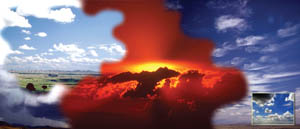
Clouds - the barrier between Earth and Space
It has been raining heavily in Sri Lanka for the past few weeks. Some
parts of the country were even flooded. So, most of us were looking up
at the sky in the morning, to see whether the sky is cloudy; because if
the sky is cloudy, it is said to be a sign of rain.
Do you know why this is so? Do you know how clouds are formed? Some
of you might know, and some of you might not. So, today, we come up with
some cloudy facts to keep you informed about these cloudy days.
Cloud types
Clouds are defined by their general appearance and the level of their
location in the atmosphere. Additionally, a prefix is frequently given
to the cloud name to indicate what level of the atmosphere it is in.
Cirro is the prefix given to high clouds. Alto is the prefix given to
mid-level clouds.

Nimbo added to the beginning, or nimbus added to the end of a cloud
name means the cloud is producing precipitation (water). The system is
by no means uniform (applicable to everything). There is no term for low
clouds, and there are some odd pairings, such as stratocumulus, which is
a cloud with two different shapes. So here's how some cloud types stack
up...
Cloud Type Appearance Altitude
Cumulonimbus Thunderheads Near ground to above 50,000 feet
Cirrostratus Thin, wispy Above thunder heads, above 18,000 feet
Cirrus Thin, often with Above 18,000 feet "mare's tail"
Cirrocumulus Small puffy clouds Above 18,000 feet
Altostratus Thin, uniform, sometimes 6,000 - 20,000 feet with "wide wale
corduroy"
Altocumulus Medium-sized puffy clouds 6,000 - 20,000 feet
Stratocumulus Broad and flat on the below 6,000 feet bottom, puffy on
top
Cumulus Puffy clouds Below 6,000 feet
Stratus Uniform, thick to thin Below 6,000 feet layered clouds
How clouds are formed
Clouds are nothing more than water vapour that condenses and gathers
into a visible form. The usual mechanism is for moisture-laden air near
the Earth's surface to be raised higher into the atmosphere, either by
an encroaching air mass or the heat of the sun. As the air is lifted,
the pressure drops and the air is subsequently cooled. The combination
of the two causes water vapour to condense.
Why clouds appear in different colours
You may be more familiar with clouds that are blue and white. If you
were to travel 20 miles or so above the Earth's surface, the sky would
appear black. Just think of the space photographs that you have seen.
What happens during light's descent to Earth that makes the sky take on
a wonderful blue hue?
White sunlight passing through our atmosphere, and molecules in the
air, primarily nitrogen, are just the right size to scatter light from
the blue end of the visible spectrum. The other colours travel to the
ground with little interference. The blue light is scattered from
molecule to molecule in the sky, until the light seems to be coming from
every direction. And the clouds are white because the water droplets
that make up clouds are much larger than the molecules that scatter blue
light.
The clouds scatter and reflect all the visible colours of light that
strike them. Hence, we have white clouds. But if the cloud is thick
enough, light does not penetrate completely through the cloud, resulting
in dark, heavy-looking cloud bottoms. We say they are the clouds that
bring rain.
Other colours occur naturally in clouds. Bluish-grey is the result of
light scattering within the cloud. In the visible spectrum, blue and
green are at the short end of light's visible wavelengths, while red and
yellow are at the long end. If the sunlight is scattered by ice, you get
greenish clouds.
A cumulonimbus cloud which shows green is a pretty sure sign of
imminent heavy rain, hail, strong winds and possible tornadoes.
Red, orange and pink clouds occur almost entirely at sunrise or
sunset and are the result of the scattering of sunlight by the
atmosphere itself.
The clouds themselves are not colourful; they are merely reflecting
the long (and unscattered) rays of sunlight, which are predominant
(primary) at those hours. The effect is the same as if we were to shine
a red spotlight on a white sheet. In combination with large, mature
thunderheads, this can produce blood-red clouds.
Compiled by Janani Amarasekara |


